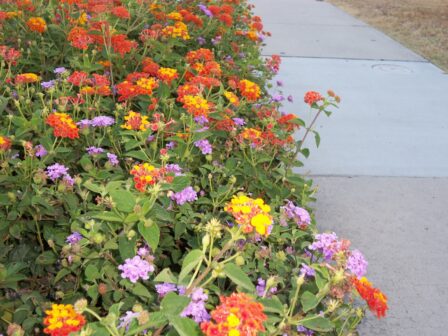Little Known Secrets of Lantana

In the garden, Lantana is a terrific groundcover plant that secretes its own herbicide to suppress the growth of weeds beneath and around it.
Like the potato, tomato, chile pepper and pinto bean, Lantana is a native of the Americas that has found its way around the world and into the common use in many cultures. Lantana, a relative of Verbena, is native to the more tropical areas of the American continents, especially the Caribbean islands, Mexico, Ecuador and parts of Texas. Of course, its bright, year-round blooms and easy growth habits have made it popular just about everywhere, except with livestock farms. (It grows vigorously enough to overtake a grass pasture and poses a risk to ruminant-type animals.)
Like so many plants of medicinal value, Lantana has a toxic element that demands knowledge and caution when using it. The same toxins that makes grazing animals sick when eaten in quantity, are the ones that make the leaves useful as cardio tonics, fever-reducers and lung decongestants, when used by humans in lower doses. A simple steam can be made of the leaves and inhaled to relieve the respiratory ill effects of influenza, colds and bronchitis. The raw leaves make an elegant and effective poultice for wounds and cuts, preventing infection and promoting the healing of the tissues; simply crush some fresh leaves and apply to the skin. The leaves produce a steroid called lancamarone which acts as a heart stimulant and toner that becomes available by steeping them into a tea. The roots contain a liver-protective triterpenoid called oleanolic acid that detoxes the liver which subsequently supports skin healing from rashes. The simmered root tea is also used for malaria, mumps and other high fever conditions. The ripe purple fruits are eaten in Malay and Sierra Leone, acting as a pleasant flavoring for meals. In Mexico, it is well-known as a treatment for snakebites, both as a strong leaf-tea and as a poultice on the puncture site. Since it is an evergreen, the leaves, blooms and berries are available year-round.
Detailed information on its chemical constituents and specific studies being done with them can be found at https://stuartxchange.com/lantana.html and, of course, at Wikipedia.
In the garden, Lantana is a terrific groundcover plant that secretes its own herbicide to suppress the growth of weeds beneath and around it. It is drought tolerant, not picky about soil, loves warm weather and attracts bees and butterflies. It comes in a wide array of bright colors; some varieties are more prostrate while others are suitable for creating thick hedges.
While the plant can definitely get out of hand in a hurry, its landscape and home remedy benefits seem to outweigh the inconvenience of keeping it pruned to a manageable size for its location. And, by pruning it often, we can be reminded that the trimmings might become the perfect tea to treat our complaints. Be sure to remember that, with this plant, more is NOT better; moderation and short term application is appropriate when using this plant as a remedy.
It is often true that the plants that grow vigorously and abundantly in your surroundings are uniquely appropriate for the ailments in the area. Lantana grows lavishly in San Diego. It may be time to become better acquainted with Lantana and the benefits beyond landscaping.
Category: Health & Fitness, Local News







